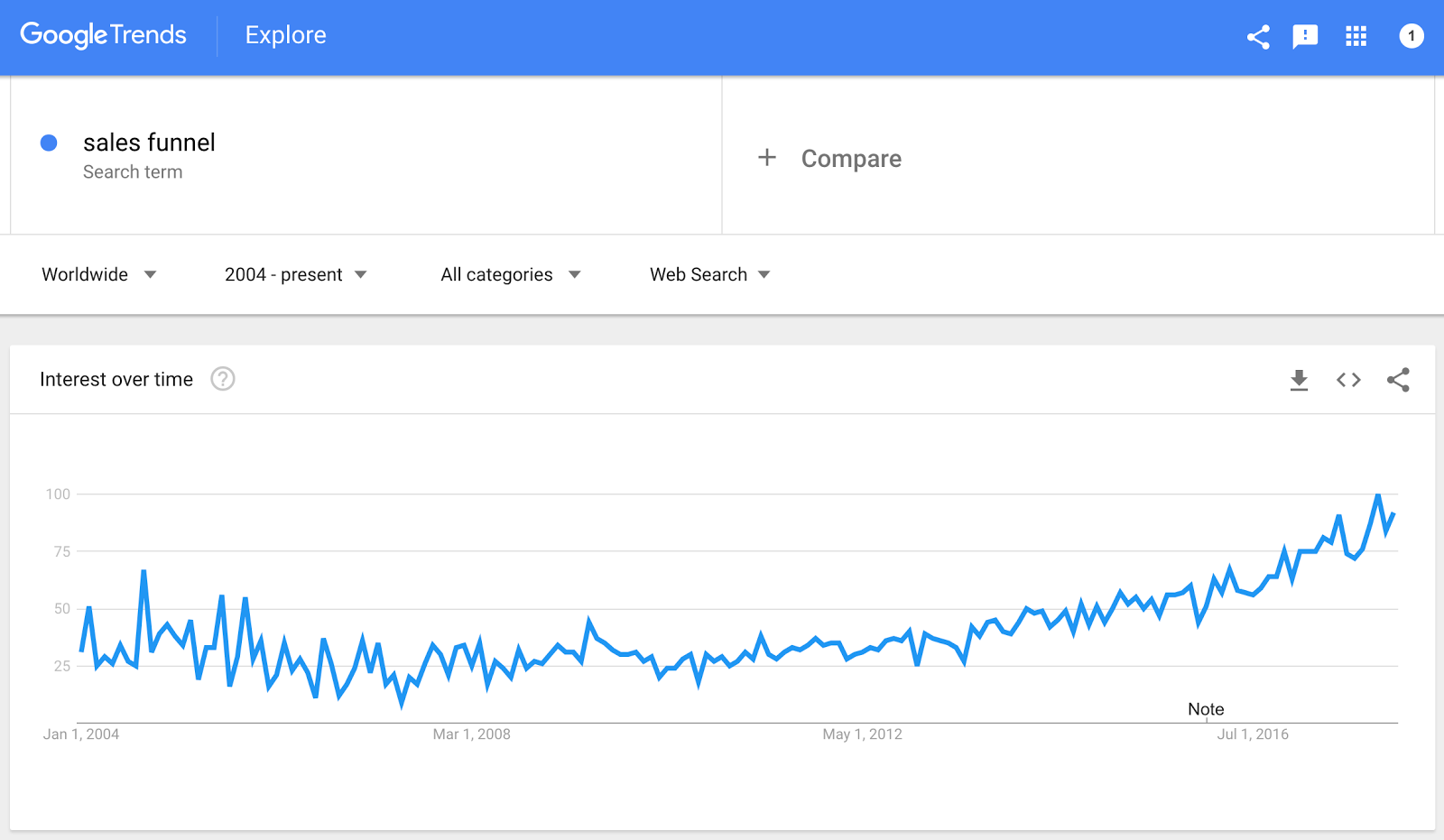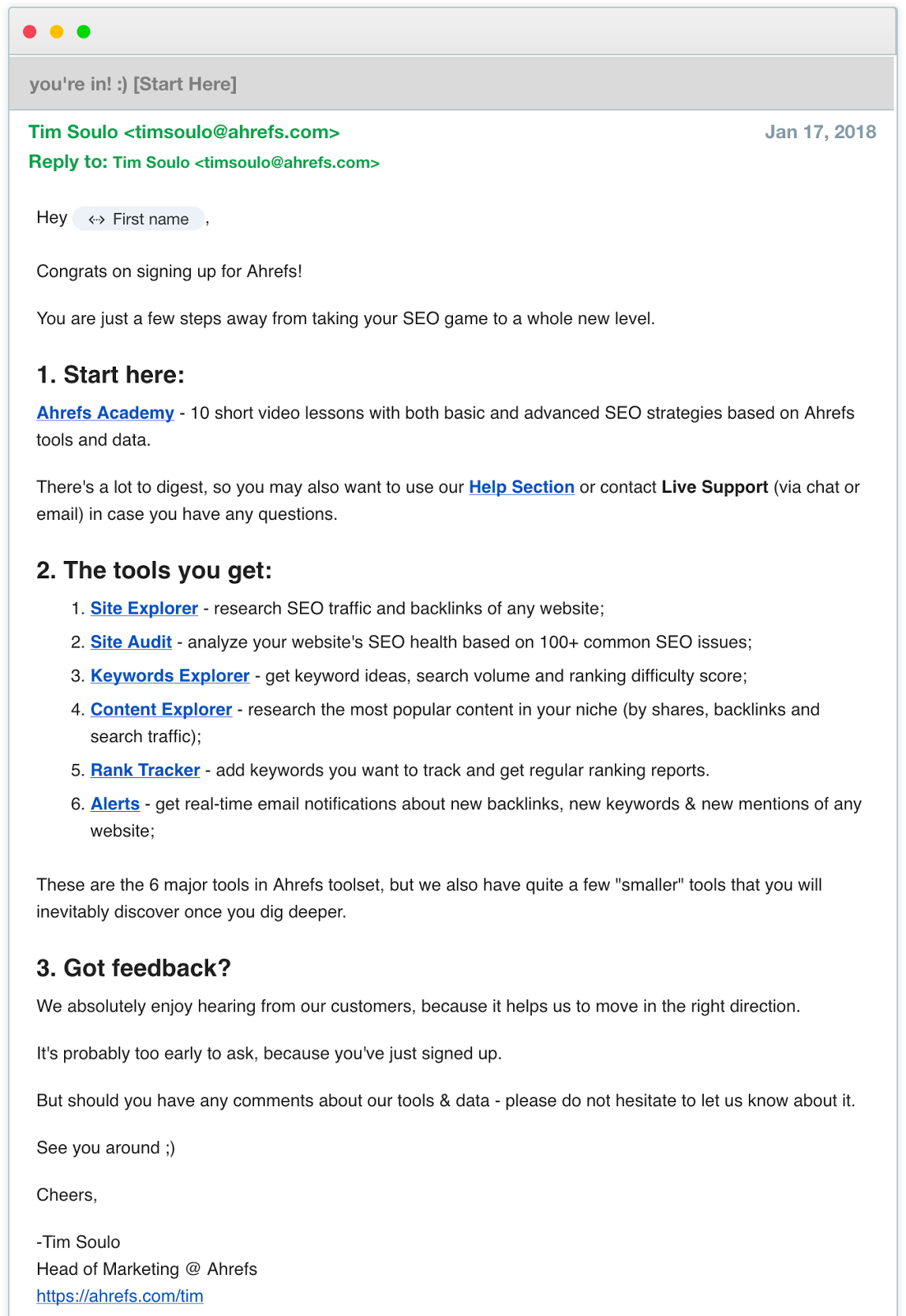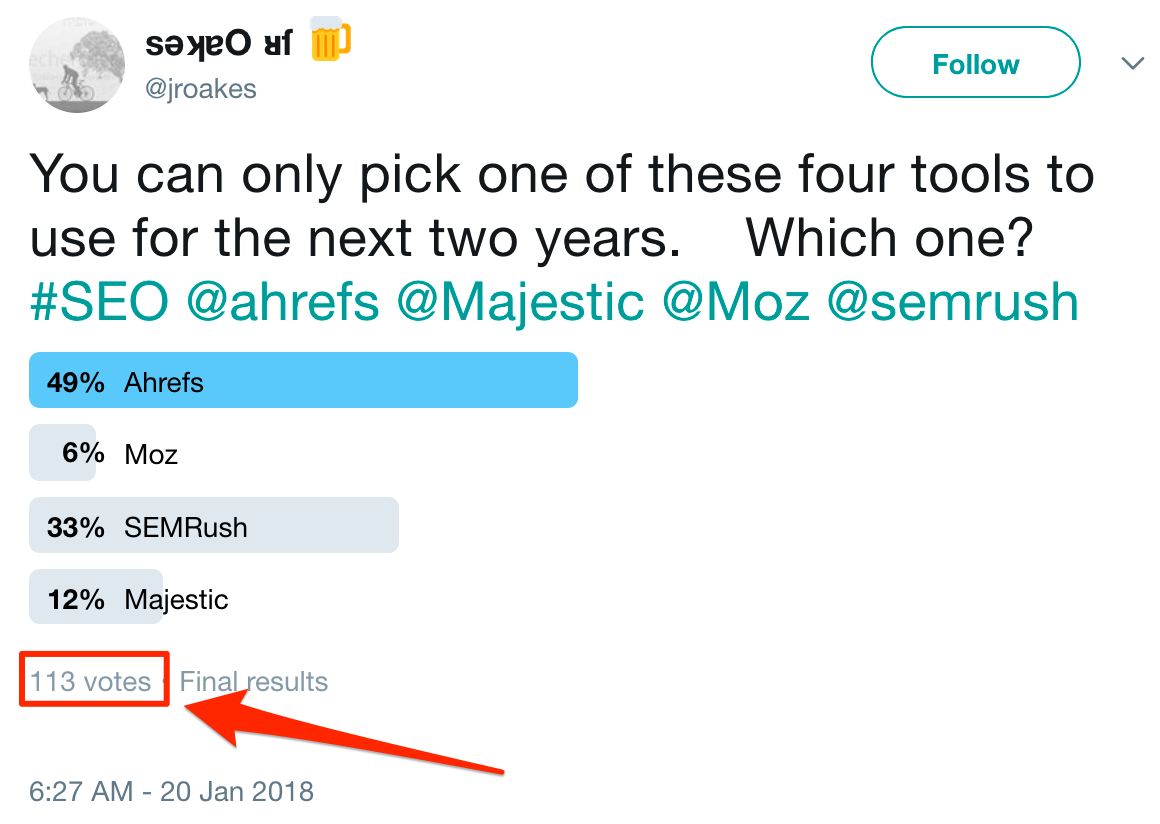How I learned to stop worrying about my sales funnel (and embraced the unpredictable)

You or I could go to any marketing conference, anywhere in the world, and we’d hear about sales funnels.
How
to build them, how to measure every inch of them, how to use the data
we’ve squeezed out of them to surge our way to success.
Sales funnels are seen as a fundamental marketing tactic; if we don’t use them, we’re missing out — big time.
And according to Google Trends, our interest in them is steadily increasing.

I
bought into this notion for a while, following the craze like a hawk,
learning everything I could about converting strangers into paying
customers.
I was 99% convinced.
Then I joined Ahrefs as CMO, and suddenly, I had enough time, money and resources on my hands to test these theories for real.
Want to see the funnel at Ahrefs that helped us grow our 8-figure ARR by +65% last year?
It’s just one introductory email:

That’s it. Done.
“But Tim!
If
you’re only sending this basic email to your leads, you’re missing out!
You need to help leads reach that Aha! moment… You need to identify
Common Conversion Activities and push your leads there… You need to
segment your leads into groups and personalize the experience for each
group…”
I get what you’re saying. But I don’t buy it.
If you’ve read my previous two articles here on Medium, you’ll know that we don’t always adopt conventional wisdom here at Ahrefs.
To explain why, I need to start elsewhere. And that elsewhere is: Aha!
You’re not Twitter, don’t act like you are
We
all know about Aha! lightbulb moments — those times when our
perspective shifts and we experience a sudden feeling of clarity.
In Silicon Valley speak, an Aha! moment denotes the point in a customer journey where a temporary user sees the light and becomes an engaged user.
The moment that turbo-charges your growth, pays off your VCs, funds your new Ferrari and lets you retire. Happily ever after.
Sounds too good to be true, doesn’t it?
- Twitter identified their ‘Aha’ moment as being when a user follows 30+ people.
- Facebook said that the ‘Aha’ moment they used was a user reaching 7 friends in 10 days.
And the list goes on and… wait. No it doesn’t.
Isn’t it odd that out of the thousands of startups we hear about, these static Aha! moments are actually few and far between?
Yes, it worked for Twitter and Facebook — but does it work for everyone?
Take Ahrefs,
a toolset for digital marketing and SEO professionals. Our onboarding
experience couldn’t be more different from that of a social media
platform.
Ok, so why do people use Twitter?
- To read the news
- To share the news
- To talk to people
Pretty straightforward.
But why do people use Ahrefs? Too many reasons to list:
- To see all links to your website;
- To see the pace of link acquisition;
- To see the latest links to your website;
- To see the most valuable links to your website;
- To see the broken links to your website;
- To see your “most linked to” pages;
- To see your anchor text profile;
- To see all of the above for any competitor website.
And
that’s only about 5% of what you can do with Ahrefs; these functions
are for backlink checking only, and we have many more tools beyond that.
The point is, our customers have a ton of different motivations and goals.
That affects our sales process, which is woven together by dozens of micro-interactions.
And in that process, there is no single identifiable Aha! moment that we can push new leads towards in our sales funnel.
I believe this applies to lots of companies — not just in SaaS.
Their reality is far more complex and nuanced than a straight funnel with a destination we can point to and say,
“that, right there, is where EVERYTHING changes”
But how about segmenting leads to create personalized walk-through for groups? Isn’t that the answer?
Well, no. And here’s why.
You’re unique, right? So how come the rest of the world isn’t?
I firmly believe that the best way for a marketer to learn about their audience is to chat — and listen — to them.
I do it a lot: on Facebook, direct messages and emails, Reddit and Slack, on our support chat. I even do one-to-ones with customers on Skype.

So, if you asked me to create some customers’ profiles, I could come up with hundreds without even scratching the surface.
To me, each customer is highly unique.
Yes,
it’s true that in the grand scheme of things, people are very similar.
And in the context of SaaS, they may well have similar problems
requiring similar solutions.
But the path that leads them to these solutions tends to be very different.
For instance:
- One person might have a bit more prior knowledge than the other, which makes their experience easier.
- One person might be short on time, while another is committed to investing time in learning.
- One person may have a friend who they can ask for help; someone else might not.
Yes, with today’s sci-fi-like technology, we can track user behavior, automate, predict problems…
But, aside from being a nightmare to set up, these systems can only measure and control what happens on your own website.
And many parts of the sales funnel happen somewhere completely different, far away from our control.
The ‘Aha’ moment you can’t measure — or control
Marketers
generally like to think of oversimplified straightforward funnels,
where people will come to a specific page on their website and have more
or less the same goals, expectations, time, budget, etc.
I don’t agree with this generalization; to me, behind each lead is a unique person with their own unique sales funnel.
And I often have a pleasure of seeing how these unique sales funnels unfold.
Here’s an example:

When dealing with our competitor, this guy was frustrated by a number of issues.
He will be feeding these into ‘the comparison test’ when he tries us out: to win the comparison test, you need to understand what it is your prospective customers value most when they compare their options — then making nailing this your main priority.
For
him, us being able to nail these issues would be his ‘Aha’ moment: and
there’s no email automation on earth that will make him stay if we
failed to deliver on them.
He didn’t use Google, which allows ranking of sales pages or display ads, to search for alternatives.
Instead, he decided to ask the question on a Slack channel (Online Geniuses) — an environment that we have no direct control over.
The
thumbs up shows that our tool was recommended by a bunch of people.
That immediately gave us a nice credibility boost right at the start of
this person’s highly unique sales funnel.
If
@sfcjonno had been browsing our landing page, we could have A/B tested
some testimonials or featured some famous customers. But in this case we
cannot control or measure how the community will react (at least not in a direct way)
Here’s another interesting one:

Over
a hundred people participated in this poll. And everyone — even those
who voted for our competitors — could see that we won.
When people are presented with a potentially superior alternative, it plants a seed of doubt.
“Are those other people getting a better deal for their money? What’s that product got that the one I use doesn’t?”
I
guarantee that some people who were signed up to our competitors
decided to give Ahrefs a spin after this poll was released — if only to
find out why we dominated it.
They
would then come to us with a) a competitor to measure us against b) one
or more features that we would have to do better than this competitor
to make them become customers.
People
rarely approach new companies with a blank slate these days; thanks to
reviews, friends, endorsements and whatever/whoever else paves their
journey to us, they come with expectations or preconceptions, even
before they check us out online.
That’s why I believe the Aha! moment often happens outside our website, our marketing or even our control.
There’s a grey area that many of us fail to take into consideration.
Like…
A bunch of guys are talking business over some beers and one of them drops your app into the conversation.
Or
A speaker at a niche conference gets a question related to your app and gives you a raving shoutout.
Or
A public discussion on Slack features your tool as an irreplaceable solution.
We can’t see
many of these things taking place, we can’t monitor them, we can’t
measure them; we just see a bunch of leads approaching us with a clear
goal/expectation/endorsement from someone they respect.
So far, so good.
But wait.
These people will then ignore your carefully-crafted landing pages and your email sequences, because they’re already on board.
Your
lead-scoring software will raise the alarm, signalling that you’re
about to lose them, and that you need to send more persuasion their way.
Now,
automation software is very clever — but it doesn’t know how or what
kind of persuasion or coaching these people have already been through
before they even made it to your website.
So,
the Aha! moment might be the reason people come to your website in the
first place — not the reason they suddenly decide to stay.
What’s your sales funnel?
The ideas in this article are based on my experience of helping Ahrefs grow.
And
while I’m happy with how things work for us right now, I want to stay
open-minded, so that I can keep experimenting and learning from others.
I’m keen to hear what your sales funnel looks like and how it works for you!
Comments
Post a Comment